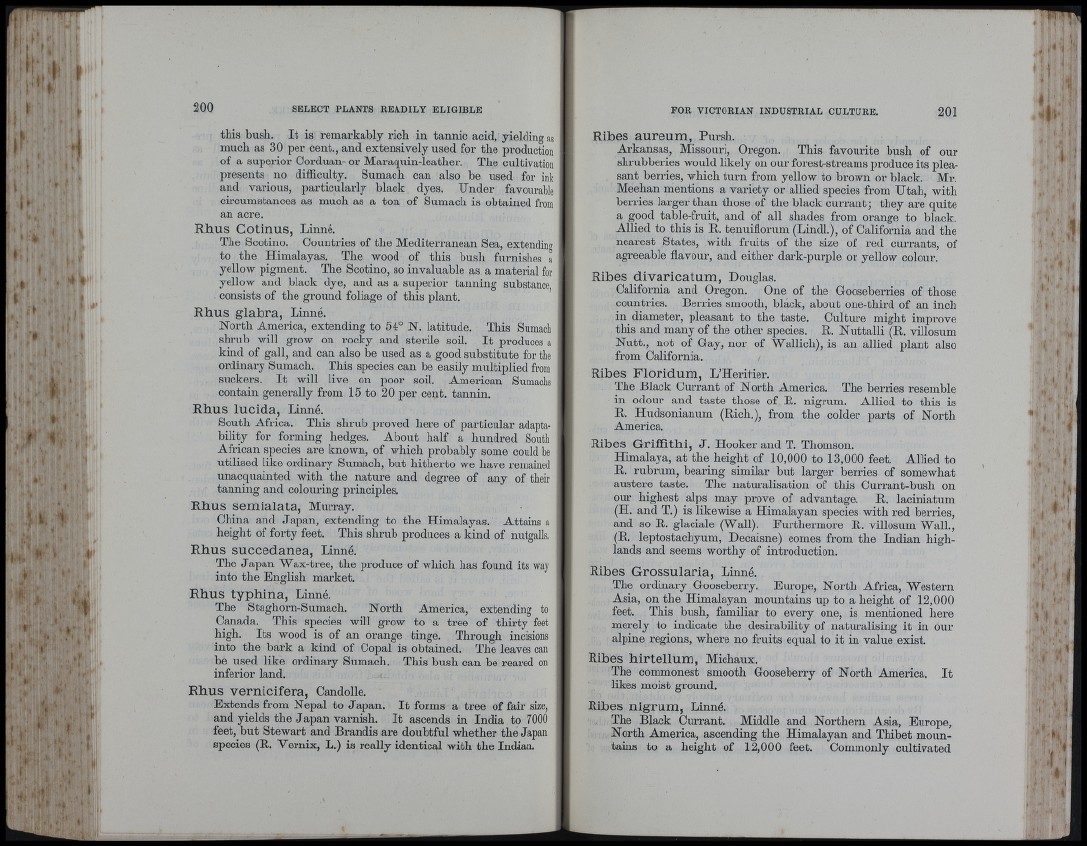
i I i
i '
il t
1
this bush. I t is remarkably rich in tannic acid, yielding as
much as 30 per cent., and extensively used for the production
of a superior Corduan- or Maraquin-leather. The cultivation
presents no difficulty. Sumach can also be used for ink
and various, particularly black dyes. Under favourable
circumstances as much as a ton of Sumach is obtained from
an acre.
Rhus Cotinus, Linné.
Tbe Scotino. Countx’ies of the Meditei-ranean Sea, extending
to the Himalayas. The wood of this bush furnishes a
yellow pigment. The Scotino, so invaluable as a material for
yellow and black dye, and as a superior tamxing substance
coxxsists of tbe grouxid foliage of tbis plant.
Rhus glabra, Linné.
North America, extendixxg to 54° N. latitude. This Sumacli
shrub will grow on rocky and sterile soil. I t produces a
kixxd of gall, and can also be used as a good substitute for the
ordinary Sumach. This species can be easily multiplied from
suckers. I t will live on poor soil. American Sumachs
contain genex'ally from 15 to 20 per cent, tannin.
Rhus lucida, Linné,
South Africa, This shrub proved here of particular adaptability
for forming hedges. About half a hundred South
African species are known, of which probably some could be
utilised like ordinary Sumach, but hitherto we have remained
unacquainted with the nature and degree of any of their
tanning and coloixring principles.
Rhus semialata, Mixrray.
China and Japan, extending to the Himalayas. Attains a
height of forty feet. This shrub produces a kind of nutgalls,
Rhus succedanea, Lixmé.
The Japan Wax-tree, the produce of which has found its way
into the English market.
Rhus typhina, Lixmé.
The Staghorxx-Sumach. North America, extending to
Canada. This species will grow to a tree of thirty feet
high. Its wood is of an oraxxge tinge. Through incisions
into the bark a kind of Copal is obtained. Tbe leaves can
be used like ordinary Sumach. This bush can be reared on
inferior land,
Rhus vernicifera, Candolle.
Extends from Nepal to Japan. I t forms a tree of fair size,
and yields the J apan varnish. I t ascends in India to 7000
feet, but Stewart and Brandis are doubtful whether the Japan
species (R. Yernix, L.) is really identical with the Indian.
Rihes aureum, Pursh.
Arkansas, Missouri, Oregon. This favourite bush of our
shrubberies would likely on our forest-streams produce its pleasant
berries, which turn from yellow to brown or black. Mr,
Meehan mentions a vaxnety or allied species from Utah, with
berries larger than those of the black currant; they are quite
a good table-fruit, and of all shades from orange to black.
Allied to this is R. tenuiiiorixm (Lindl.), of California and the
nearest States, with fruits of the size of red cux-rants, of
agreeable flavour, and either dark-pui-ple or yellow colour.
Ribes divaricatum, Douglas.
California and Oregon. One of the Gooseberries of those
countries. Berries smooth, black, about one-third of an inch
in diameter, pleasant to the taste. Culture might impx’ove
this and many of the other species. R. Nuttalli (R. villosum
Nutt., not of Gay, nor of Wallich), is an allied plant also
from California.
Ribes Floridum, L’Heritier.
The Black Currant of North America. The berries resemble
in odour and taste those of R. nigrum. Allied to this is
R. Hixdsonianum (Rich.), fx’om the colder parts of North
Amei-ica.
R ib e s Griilithi, J . Hooker and T. Thomson.
Himalaya, at the height of 10,000 to 13,000 feet. Allied to
R. rubrum, bearing similar but larger berries of somewhat
austere taste. The naturalisation of this Curi-ant-bush on
our highest alps may prove of advantage. R. laciniatnm
(H. and T.) is likewise a Himalayan species with red berries,
and so R. glaciale (Wall). Furthermore R. villosum Wall.,
(R. leptostachyum, Decaisne) comes from the Indian highlands
and seems worthy of introduction.
Ribes Grossularia, Linné.
The ordinary Gooseberry. Europe, North Africa, Western
Asia, on the Himalayan mountains up to a height of 12,000
feet. This bush, familiar to every one, is mentioned Ixere
merely to indicate the desirability of naturalising it in our
alpine regions, where no fruits equal to it in value exist.
Ribes hirtellum, Michaux.
The commonest smooth Gooseberry of North America. I t
likes moist ground.
Ribes nigrum, Linné.
The Black Currant. Middle and Northern Asia, Europe,
North America, ascending the Himalayan and Thibet mountains
to a height of 12,000 feet. Commonly cultivated
I',